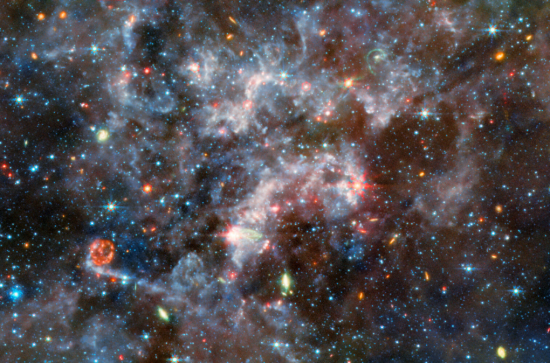
A new image from the James Webb Space Telescope, featuring the work of Dr Patrick Kavanagh, Department of Experimental Physics, was chosen as a European Space Agency’s Webb Picture of the Month for July 2023.
The image shows galaxy NGC 6822, one of our nearest galactic neighbours 1.5 million light-years away. The galaxy NGC 6822 largely comprises dust and the gases hydrogen and helium, which are usually associated with conditions in the early universe. It is of interest to scientists to help understand how processes such as the evolution of stars and the life cycle of interstellar dust likely occurred in the early universe.
The metallicity of NGC 6822 is only about 6% of that of the Sun. Metallicity refers to the quantity of hydrogen and helium in comparison with other elements in an object such as a star or a galaxy. It is a key concept in astronomy, in part because elements other than hydrogen and helium are largely produced by stars over their lifetimes.
In the very early universe before the first generation of stars was born, lived and died, everything had very low metallicity. This was the motivation for these observations of NGC 6822 with Webb: to better understand how stars form and how dust evolves in low-metallicity environments.
This image shows NGC 6822 as observed by the Mid-InfraRed Instrument (MIRI) mounted on the NASA/ESA/CSA James Webb Space Telescope. MIRI probes the mid-infrared, which in this case makes it perfectly suited to observe the dense regions of gas that suffuse this galaxy.
Dr Kavanagh worked on the development and commissioning of JWST/MIRI instrument and performed the data reduction and processing that led to this spectacular galactic vista.
What you can see in the image:
At mid-infrared wavelengths the emission of light by galactic dust is prominent, obscuring the galaxy’s stars which themselves are faint at longer mid-infrared wavelengths.
Brilliant blue gas: indicates light emitted by organic compounds called polycyclic aromatic hydrocarbons, which play a critical role in the formation of stars and planets.
Cyan: marks cooler patches of dust, while warmer dust is more orange.
Orange: are distant galaxies far beyond NGC 6822.
Green: The few galaxies that are relatively closer are marked by their own light-emitting dust, which MIRI can pick out.
Bright red and magenta: active areas of star formation in the galaxy. With so many stars, supernova explosions are routine.
A red ring just below left of centre: an amazing example of a supernova remnant
Text credit: ESA/Webb
See ESA JWST image of the month here
